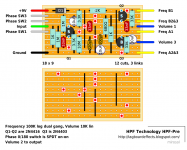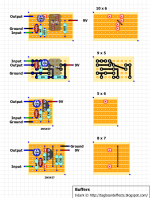Do you have an example circuit for 9V supply?Simple answer is you can't.
To make an individual discrete buffer inverting requires an additional stage or a total reconfiguration of the single FET but it then would not be a buffer.
Far better if you want phase inversion would be to use a single inverting stage at the output to invert everything. An opamp is the logical solution for that.
It would be like this. The gain equals -(R2/R1) the minus denotes phase inversion. So two equal value resistors give a gain of -1
R3 and R4 generate a midpoint voltage equal to the supply divided by 2. Keep the two resistors the same value in the 20k to 100k range.
The input is DC coupled from the FET driving it but this does assume the FET is also biased to approx half the supply. You can AC couple, but this saves a cap.
C1 AC couples the output and provides a ground referenced output voltage. R5 and R6 are good practice although some would omit these... you shouldn't.
You can see the phase inversion of the output signal here. The opamp should be a low power rail to rail type if you are using a 9v battery although it will work with pretty much any common device.

R3 and R4 generate a midpoint voltage equal to the supply divided by 2. Keep the two resistors the same value in the 20k to 100k range.
The input is DC coupled from the FET driving it but this does assume the FET is also biased to approx half the supply. You can AC couple, but this saves a cap.
C1 AC couples the output and provides a ground referenced output voltage. R5 and R6 are good practice although some would omit these... you shouldn't.
You can see the phase inversion of the output signal here. The opamp should be a low power rail to rail type if you are using a 9v battery although it will work with pretty much any common device.
Ok, thanks.
I have a slightly unrelated question regarding safety. I am currently planning to build a a tube amp myself and even though it will be low power (5W), I am aware of the dangerous voltages associated with tubes.
My question is: If I wear a metal wristband on both arms that connects to my house's ground, can I avoid lethal discharges (burnt fingers max)?
I have a slightly unrelated question regarding safety. I am currently planning to build a a tube amp myself and even though it will be low power (5W), I am aware of the dangerous voltages associated with tubes.
My question is: If I wear a metal wristband on both arms that connects to my house's ground, can I avoid lethal discharges (burnt fingers max)?
That sounds highly dangerous tbh because you automatically become grounded via the bands leaving you highly exposed to any possible shock hazard from touching anything accidently.
A suitable bleeder resistor across any reservoir cap should ensure the unit is safe once disconnected from the power. If you have doubts measure across any caps to check for residual voltage.
A good high voltage 'belt' across the fingers is unpleasant but nothing more although you wouldn't want that to travel through your body. A good rule of thumb to get used to is only ever put one hand into a piece of equipment that carries high voltage.
A suitable bleeder resistor across any reservoir cap should ensure the unit is safe once disconnected from the power. If you have doubts measure across any caps to check for residual voltage.
A good high voltage 'belt' across the fingers is unpleasant but nothing more although you wouldn't want that to travel through your body. A good rule of thumb to get used to is only ever put one hand into a piece of equipment that carries high voltage.
Ok, noted. The idea was that it's better to get a few shocks here and there in the fingers than a high voltage travelling across my heart.
Anyway, I just discovered a veroboard layout for a preamp specifically designed for double bass piezo signals. The main advantage is that it has a built-in HPF and also a phase switch.

Can I just use this as the master buffer in my design after the individual JFET buffers have been summed?
Anyway, I just discovered a veroboard layout for a preamp specifically designed for double bass piezo signals. The main advantage is that it has a built-in HPF and also a phase switch.

Can I just use this as the master buffer in my design after the individual JFET buffers have been summed?
The idea was that it's better to get a few shocks here and there in the fingers than a high voltage travelling across my heart.
That is the reason for only ever putting one hand into live equipment or equipment where there is a risk of having large caps charged to a high voltage.
Can I just use this as the master buffer in my design after the individual JFET buffers have been summed?
Would need to see the circuit diagram... or you can draw it out from the layout 😉
I can try....That is the reason for only ever putting one hand into live equipment or equipment where there is a risk of having large caps charged to a high voltage.
Would need to see the circuit diagram... or you can draw it out from the layout 😉
But I guess if the design works for high impedance piezos, it should also work with a buffered signal, right?
Since there is only one input (as opposed to Input+ and Input-) I would assume that the phase reversal also remains functional.
Essentially yes but remember if the design is specifically for double bass then the response may be deliberately modified (HF roll off etc). Only by seeing a true circuit can we tell easily.
Sorry but no, it can be DEADLY.Ok, thanks.
I have a slightly unrelated question regarding safety. I am currently planning to build a a tube amp myself and even though it will be low power (5W), I am aware of the dangerous voltages associated with tubes.
My question is: If I wear a metal wristband on both arms that connects to my house's ground, can I avoid lethal discharges (burnt fingers max)?
Shocks in tube amps are mostly to the power supply, NOT house ground.connects to my house's ground
I wonder if I could just put all transducers in parallel and use the very basic JFET buffer without a HPF or any trim pots (third one in the pic). That is apart from the regular tone and volume controls in my bass obviously.
In my latest tests the string to string volume was pretty even so I don't think I even need individual trim pots and opamps or multiple buffer stages.
What do you think?
Is a HPF necessary to avoid speaker damage?
How would the behaviour of the transducers change when put in parallel?
In my latest tests the string to string volume was pretty even so I don't think I even need individual trim pots and opamps or multiple buffer stages.
What do you think?
Is a HPF necessary to avoid speaker damage?
How would the behaviour of the transducers change when put in parallel?
Attachments
Last edited:
Sorry, don't have those. Why would you go for that one instead of one of the simpler two at the bottom?
What kind of impedance do piezo saddles have anyhow? Could putting them in paralle reduce it far enough that you might be able to use them passively and/or blend with magnetics?
Last edited:
- Home
- Live Sound
- Instruments and Amps
- 4ch Piezo Buffer - Do I Need to Match the JFETs?
